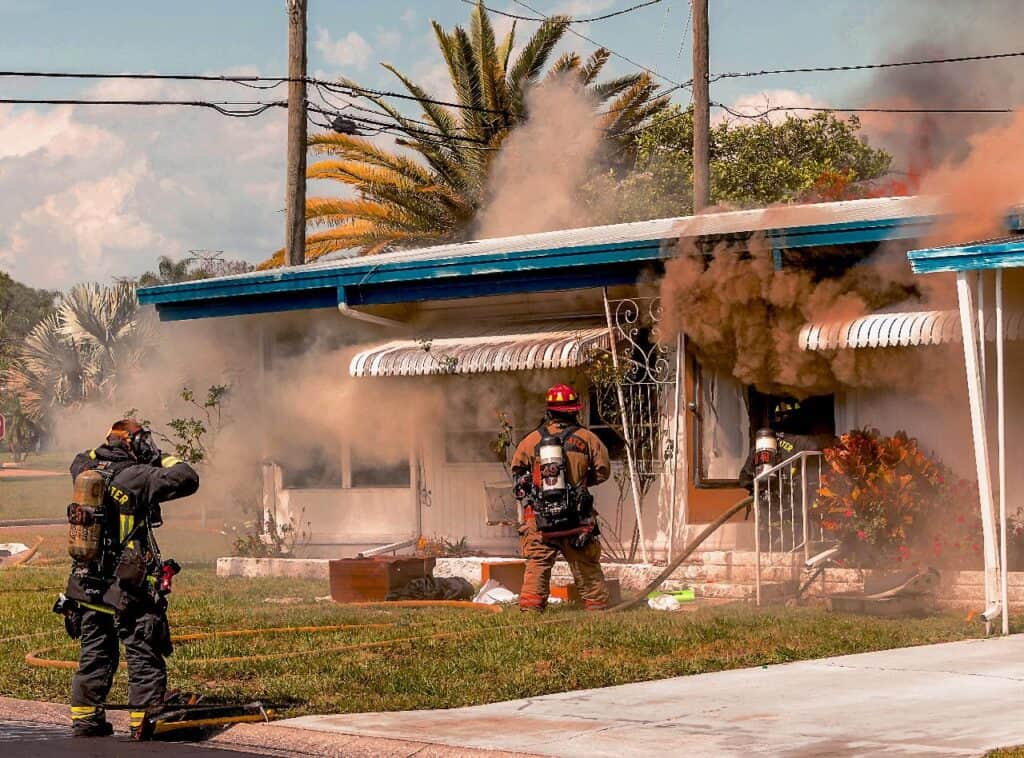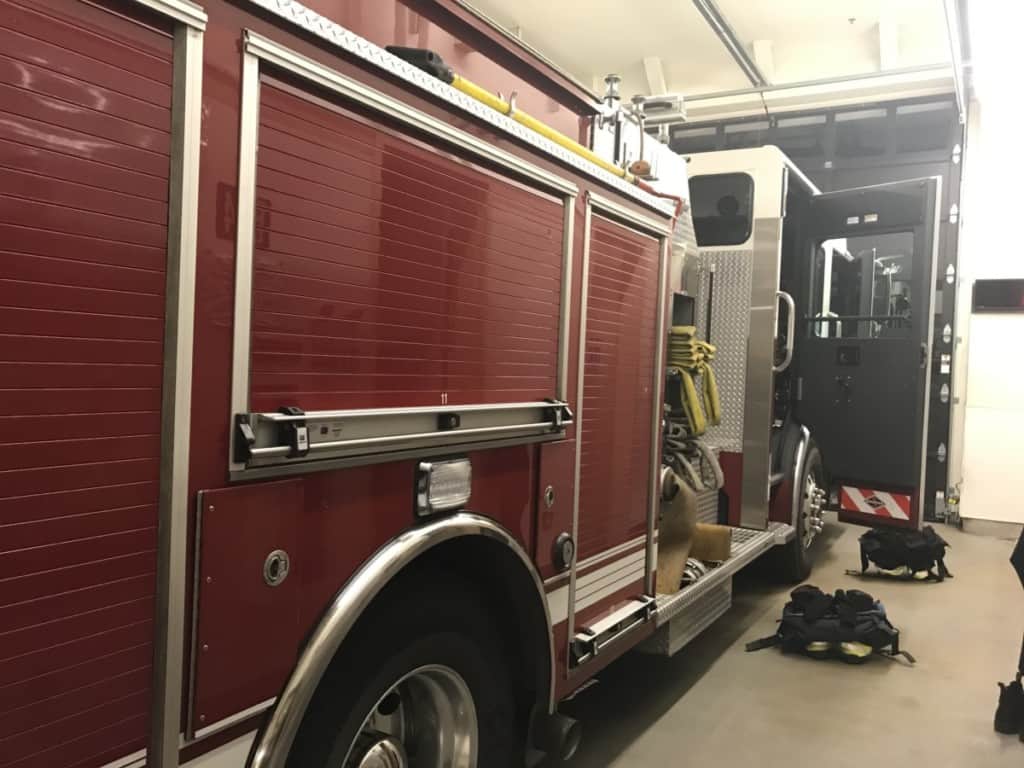Firefighting can be a hard job and one of the hardest things to deal with is burning buildings. This is not just because of the heat, but also because of the impact on human life. You may be wondering just how hot a simple house fire can become and what do if a fire breaks out in your home? Let’s see.
A standard house fire can reach temperatures of up to 1500 degrees Fahrenheit (815 Celcius). It will always be hottest at the ceiling, as heat rises. However, it can still easily be a few hundred degrees or more at the floor level.
House fires are fairly common and can obviously be very dangerous, even for firefighters. Let’s us take a look at just how hot fires can get, the factors that effect the temperatures of a fire and the basics off what to do in a house fire. Here’s what you need to know.
Your # 1 priority is keeping your family safe. As a firefighter, I recommend everyone has updated smoke detectors that don’t require battery changes, like these ones from Kidde, a fire extinguisher, like this one from Amerex, and a fire escape ladder if you have bedrooms above the first floor, I recommend this one from Hausse.
Also read: What Is The Temperature Of Fire? How Hot Does it Get?
Average House Fire

The first thing you need to know about fire is that heat rises and so does smoke.
Both of these things can make a big difference in a fire. That means the lowest temperature in a fire is usually at the same level as your feet. In a typical house fire, the floor will reach at least 100 degrees, but often much hotter. This is hot enough to be very uncomfortable and potentially give long enough exposure to it – it can burn you.
However, if you move up just a little to your eye level the heat will usually be around 600 degrees. To put that in context, go and have a look at the oven in your kitchen, it almost certainly doesn’t go up that high! So, this is very hot, indeed.
By the time you get to the ceiling, things tend to be super-heated. The temperature at the ceiling could be 1,500 degrees and that’s a pretty scary number. When things are that hot, your clothes quite literally melt onto your skin and you can burn your lungs just by breathing the air at this temperature.
Very dangerous. That is why we are always told to stay low in a fire, the temperatures are much more tenable and it tends to be less smoky for breathing.
Firefighters use thermal imaging cameras (TICs) to help with visibility and read temperatures in a fire, check it out:
Also read: Black Smoke: What Does It Mean And What Causes It? and How Fast Does Fire Spread? (House Fire, Wildfire)
How Hot Can They Get?
Can a house fire get hotter than 1,500 degrees?
Well, yes, it can. It’s not impossible for a typical house, in the right circumstances (or from the owner’s perspective, the wrong circumstances) to reach 2,000 degrees, but this would be atypical.
If, on the other hand, the house is full of flammable materials (think propane used for welding or gas supply) then things could get hotter still.
A full-on propane fire can breach 3,500 degrees! That means it’s a very sensible precaution to get anything super flammable out of your home and in a location where it doesn’t present a risk to your safety and the safety of your family.
But at a certain point, does it really matter? Humans can’t survive in 1500 degrees, so 2000 is really no different.
Also read: Firefighters, What Does A Burning Body Smell Like? or Are Diamonds Flammable? Will They Burn In A Fire?
Potential For “Flashover”
The biggest concern in a house fire beyond the immediate heat and smoke is what’s called a “flashover”.
Flashover is a thermally-driven event during which every combustible surface exposed to thermal radiation in a compartment or enclosed space rapidly and simultaneously ignites. Flashover normally occurs when the upper portion of the compartment reaches a temperature of approximately 1,100 °F for ordinary combustibles.
usfa.fema.gov
This takes place when the room is incredibly hot, and all the smoldering and burning are generating gases that are easily combustible.
Eventually, like smoke, these gases rise and when they reach the right temperature to combust, they quite literally ignite, and everything in the room (assuming there’s still some oxygen at ground level) catches fire at once.
To get a look at just how fast a house fire can grow and spread, watch this training fire that shows a flashover:
A flashover can smash your windows and doors open and this isn’t good news.
This allows fresh air to rush into the room and what’s in the fresh air? Yes, that’s right lots of fresh oxygen which will help the flames to burn longer and hotter, which, in turn, means that the fire is more likely to spread throughout the property.
Also read: Should You Open Windows During A Fire? Is It A Good Idea?
What Kind Of Damage Do They Cause?
So, what kind of damage does this lead to?
Well, hopefully, you spot the fire and you act very quickly to get it under control – then you might find that the answer is “not much”.
Note: Never try to control a fire that you are unable to, call for emergency service (911 in the US) and the fire department will come to do their job.
However, it takes as little as 30 seconds for a tiny flame to become a raging fire that you can’t get under control and that fire may take just a couple more minutes to become fully life-threatening.
This will result in two types of damage to your home: fire damage and smoke damage.
Fire damage is at sounds. It’s caused as the materials of your home and property burn, smolder and possibly create flashover. This can lead to structural damage (roofs, in particular, are prone to collapse from fire damage) and they may affect the provision of power and sewerage services too.
Smoke damage is no better. Sadly, smoke damage leads to oily soot coating nearly everything that it comes into contact with and it can’t be removed. It’s worth noting that smoke is more deadly than fire to the occupants of the home and breathing too much smoke can lead to suffocation and is three times more likely to be fatal than the fire itself.
Also read: Is It Safe To Sleep In A House After A Small Fire?
What To Do During A House Fire
OK, so what do you do if you have a fire raging in your home?
- Call 911 or another emergency number as soon as possible for help.
- Get down low and crawl under smoke – smoke and heat rise, try and avoid them if you can.
- Always cautiously feel a doorknob before opening it – if it’s hot or there’s smoke billowing around a door, don’t open it, find another exit, instead.
- If you do open a door, do so slowly – if you see flames or heavy smoke, shut it again and find another exit
- If you have people or pets trapped inside, you should inform firefighters when they arrive on the scene, so they can try to save them
- If you are trapped inside, close all the doors to the room you are in, cover all vents, cracks, etc. with clothing, cloth and then call for the fire department or 911.
- If you catch fire – then stop, drop and roll (we discuss this at greater length in this article)
Sources: Ready.gov and redcross.org
In this video, a firefighter shows some of the fire safety basics and demonstrates the best way to escape during a house fire:
Also read: What To Do If The Fire Alarm Goes Off In Your Apartment?
What Should People With Limited Mobility Do?
If this is the case, then you can:
- Try to live and stay near an exit. Sleeping on the ground floor might seem a bit odd but it’s a good plan if you can do it. Getting down stairs can be a real struggle at the best of times, in a fire, it may be more than you can manage.
- For those who use wheelchairs or walkers – please make sure, in advance, that they fit through every door between you and the way out.
- If you need ramps, doorways widened etc. to enable your escape – get it done, it will be too late if the places catches fire and this isn’t done
- Get your family, friends or building crew to help you practice a fire drill or two so that you can be sure you can get out
- Speak to your local fire service and ask them to make a note of your special needs and place it on record
- Always have a phone close to hand so that you can call in the event of an emergency
Source: Ready.gov
Also read: Is Fiberglass Flammable or Fire Resistant?
Conclusion
House fire temperature: how hot do they get? Very hot, indeed. Even assuming that your house isn’t full of things that burn very hot (and thankfully, most homes are not) then the maximum temperatures can reach is 1,500 degrees.
That’s hot enough to, quite literally, melt your clothing onto your skin and to burn your lungs as you breathe in the hot air. Fortunately, heat rises and if you are in a burning building, you can escape much of the heat (and the worst of the smoke) by keeping low as you try to exit the burning area.
Related Articles:
Can Christmas Lights Start A Fire?
At What Temperature Does Paper Burn/Ignite? Revealed
Symbolism of Fire: Spiritual, Dreams, History

